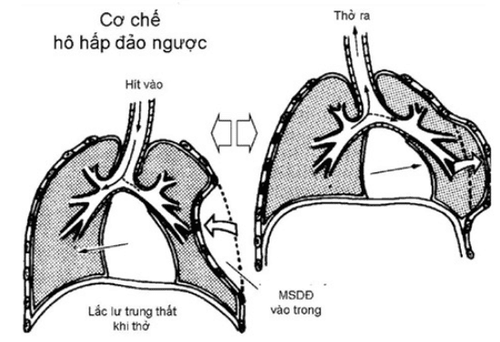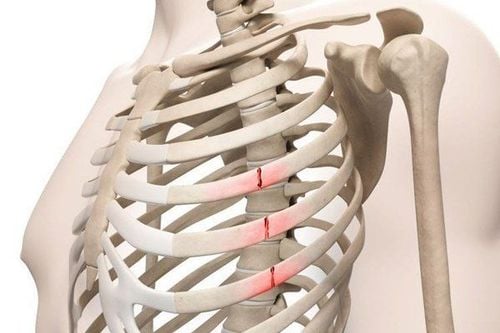This is an automatically translated article.
Respiration can be caused by any number of reasons. This is also a rare but severe sign and quickly leads to respiratory failure, circulatory collapse, especially in the case of trauma. Accordingly, medical staff, even the average person, need to know what respiratory reverse is so that they can initiate oxygen support treatments if detected in time.
1. What is Respiration?
Respiration is generally a term that refers to a pattern of breathing that is the opposite of normal breathing. In a normal, healthy breathing pattern, when inhaling, the diaphragm moves downwards. At the same time, the abdominal wall will extend outward relative to the spine. During expiration, the diaphragm will then move upward and the abdominal wall will contract inwards toward the spine. This is also known as diaphragmatic breathing or abdominal breathing, where the chest is not moving.
Thus, when respiratory reverse occurs, the way the patient breathes will be opposite to the way the diaphragm breathes up. Thus, not only is one of the unusual states of respiratory distress, in some cases, paradoxical respirations can often be acute and require urgent action. In rare cases, though, it can be a chronic problem or can flare up under stress, causing panic attacks or long-term shortness of breath.

Hô hấp đảo ngược được mô phỏng qua ảnh minh họa
2. Signs of Respiratory Reversal
The following is a list of common signs and symptoms that a patient is experiencing respiratory reverse, which may include respiratory failure:
Shortness of breath or a feeling of being unable to breathe Shortness of breath Panting, involuntary, Sudden deep breathing Tachycardia, Neck and shoulder pain, Chest pain or weakness, Dizziness
3. Causes of Respiratory Reversal
Several factors can contribute to the respiratory inversion pattern as follows:
Acute chest trauma is one that will lead to immediate intercostal spasms. In turn, this condition can cause a paradoxical movement in the breath. In this case, urgent actions must be taken to help support respiratory function.
However, chronic problems can also contribute to prolonged RPR:
Prolonged stress : When suffering from chronic stress due to work or psychological stress issues, people The disease has a tendency to reverse respiration, sometimes referred to as double breathing or even hyperventilation. Posture: People who sit at a desk all day may also find that the upper shoulder muscles, especially the muscles in the neck, become tight and painful. As a result, the respiratory system requires excessive use of the major respiratory muscles when breathing. This can lead to the diaphragm weakening rapidly and acting in a paradoxical way when breathing. In the long run, the effects then reciprocate, resulting in breathing becoming more and more difficult and muscles becoming more and more tense and painful. Nerve damage: Certain neurological problems, such as epilepsy or migraines, can trigger a paradoxical response, impeding diaphragmatic movement and causing irreversible respiratory distress. through the diaphragm. Lung damage: People with lung-related health problems such as lung cancer, chronic obstructive pulmonary disease (COPD), asthma, etc. will often have paradoxical upper chest wall breathing.

Chấn thương ngực cấp tính có thể gây tình trạng hô hấp đảo ngược
4. Respiratory Reversal Treatments
For patients who are found to have signs of respiratory reversal with acute episodes of dyspnea due to chest trauma or other physical impairment that interferes with the body's ability to receive oxygen according to the body's needs, emergency.
In the event of respiratory reverse due to a panic attack or hyperventilation, when the person is gasping for breath, try the following immediate actions that can help calm the patient and restore normal breathing :
Do a squat and put your hands on your knees Breathe with pursed lips Hold and do your best to slow your breathing Don't try to talk Focus on a visual point in front of you, about 1 meter away meters Once you're able to regain your breath, try belly breathing (inhale so your belly is facing out and exhale so your belly is inward)
5. How to prevent respiratory reverse?
5.1 Practice proper deep breathing Go to a quiet place alone, free of distractions with a good posture to maintain stretch. Close your eyes gently. Exhale all the air out of your lungs. Then, slowly inhale through your nose, so that: The abdominal wall is open to the outside Chest and shoulders are not moving When you take a deep breath in, begin to exhale through your mouth so that: The abdominal wall collapses toward the spine. Chest and shoulders are not moving 5.2 Practice even breathing Regular breathing is a simple exercise that calms irritated nerves, reduces stress, and induces a relaxation response. Practice this whenever you feel overwhelmed or can't breathe.
Here's how:
Using the proper breathing pattern above, start by taking one deep breath for a slow count from one to four Hold the breath in your lungs and also count from one to four Slowly exhale and Hold the breath again for the same time. Repeat this four-step procedure for about one to two minutes. In a nutshell, respiratory inversion occurs when, instead of moving down on inhalation and upward on exhalation, the diaphragm moves upward on inhalation and downward on exhalation. This reverse breathing pattern can cause shortness of breath, poor oxygen absorption, weakness, trouble sleeping, and other short- and long-term complications. In acute cases, respiratory reverse can also be a life-threatening symptom in people with diaphragmatic paralysis or severe trauma. Therefore, it is important to seek medical attention and treatment promptly, sometimes requiring urgent action to avoid a serious event later.
Please dial HOTLINE for more information or register for an appointment HERE. Download MyVinmec app to make appointments faster and to manage your bookings easily.













